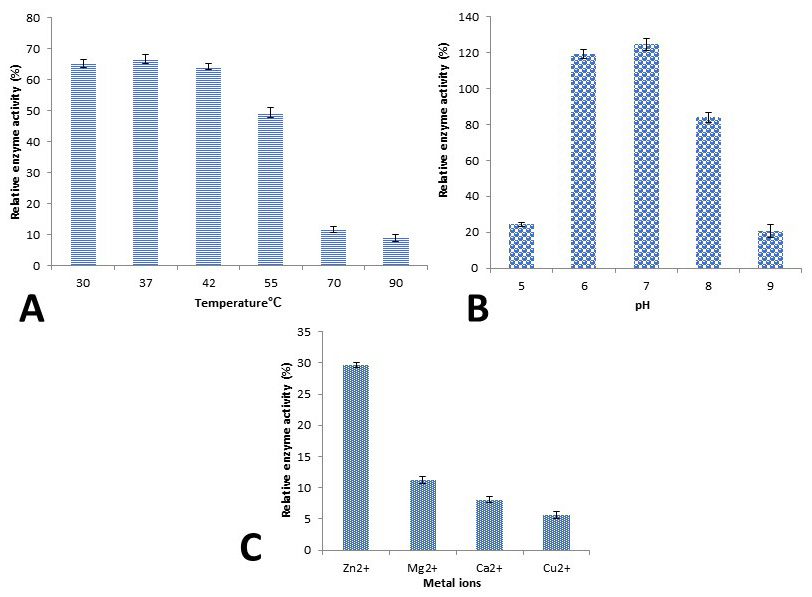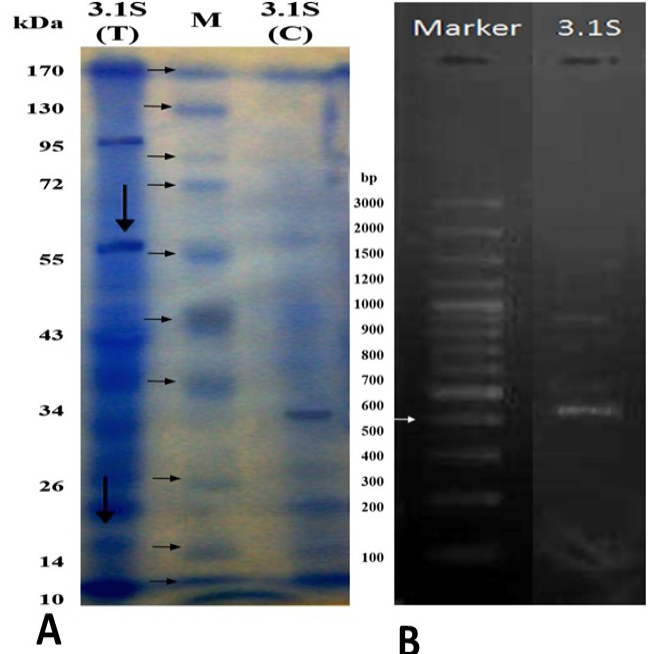Multiple Metal Resistant Bacillus cereus 3.1S Isolated from Industrial Effluent has Promising Arsenite Oxidizing Potential
Multiple Metal Resistant Bacillus cereus 3.1S Isolated from Industrial Effluent has Promising Arsenite Oxidizing Potential
Ayesha Noreen1, Amina Elahi1, Dilara Abbas Bukhari2 and Abdul Rehman1*
Neighbor-joining methods based tree of selected B. cereus 3.1S strains. B. anthracis strain MSEB 37 (KP261079.1), B. cereus strain GVK 8 (KY777586.1), Bacillus sp. strain VM-4 (MK424275.1), Bacillus sp. strain SXMCr-4 (JN606323.1), B. cereus strain CIIE (HQ388815.1), B. cereus strain D26 (KC441765.1), B. cereus strain NIOER273 (MG205987.1), and B. cereus strain TS22 (JQ727436.1).
Growth pattern of B. cereus 3.1S growing in 100 μgAs3+//ml and without As3+ in minimal salt medium.
Appearance of brown precipitates on plate, containing 100 μgAs3+/ml, is showing the arsenite oxidizing ability of B. cereus 3.1S as compared to the control in AgNO3 assay (A), Concentration of As5+ transformed during extra and intra-cellular enzyme activity (B), Enzyme assay for soluble fraction of bacterial isolate 3.1S (C).
Effect of temperature (A), pH (B) and metal ions (C) on arsenite oxidase activity.
A: SDS-PAGE of bacterial isolates intracellularly with arsenite and without arsenite in the culturing medium. On right hand side is marker a line (M), next to it, control sample of 3.1S (C) and 3.1S (T). Treated sample have the arsenite in the medium and represented with (T) while control does not have arsenite in the medium and marked with (C). B: Agarose gel (1%) is showing the amplified product of arsenite oxidase gene from B. cereus 3.1S. Lane marker and 3.1S is showing DNA marker and B. cereus, respectively.
As3+ oxidation (%) by B. cereus 3.1S from industrial wastewater after 3 and 6 days of incubation at room temperature.
Growth of Vigna radiata (mung beans) in microbially treated wastewater (B. cereus 3.1S), tap water and untreated wastewater after 10 days of incubation under 1:1 light and dark period.
Proposed As3+ resistance and oxidation mechanism in gram positive bacterium, B. cereus 3.1S. (1) As3+ oxidizes into As5+ extracellularly by arsenite oxidase. (2) As5+ enters into cell cytoplasm. (3) As5+ reduces into As3+ by reduced molecules e.g., GSH and ATP. (4) As3+ induces DNA to make arsenite oxidase which converts As3+ into As5+. (5) As3+ is also involved in the generation of ROS and the oxidative stress resulted by the formation of ROS is combated by antioxidant molecules including glutathione and non-protein thiols. Metallothionenis are involved in metal scavenging process. (6) After certain level of accumulation, As3+ expel out through the efflux system.

















